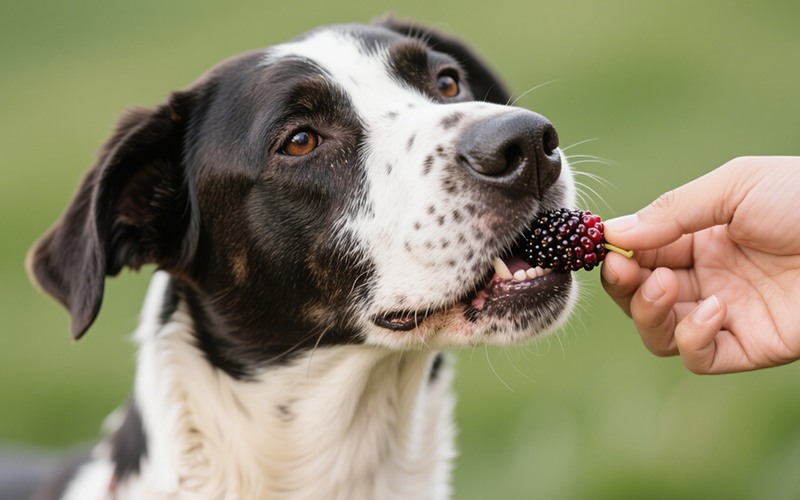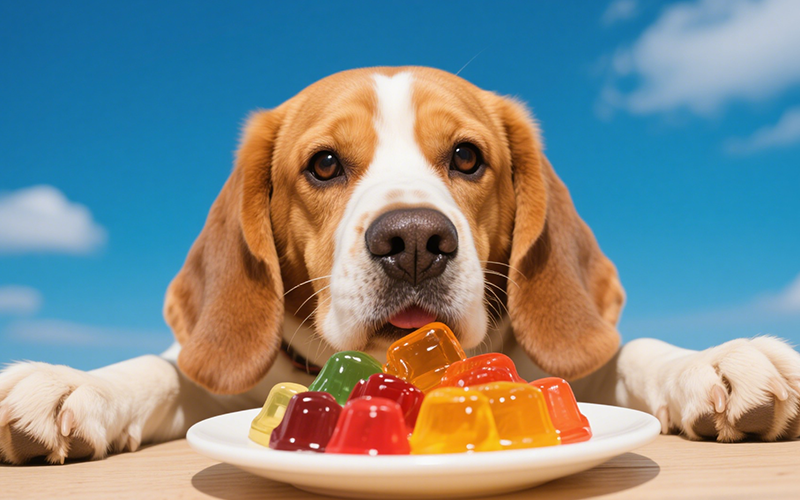Can Dogs Eat Mulberries? Vet Explains Safety, Benefits & Potential Risks
- 16 Apr 2025 10:39
As seasons change, different fruits become available, tempting us with their unique flavors. Mulberries, those small, juicy berries resembling elongated blackberries, might grow in your yard or appear at local markets. Seeing your dog's curiosity piqued by these dark berries might make you wonder: can dogs eat mulberries? The good news is that **yes**, ripe mulberries are generally considered **safe** for dogs to eat in moderation. Unlike some other berries (like holly or mistletoe berries) or fruits (like grapes), mulberries are not known to contain compounds acutely toxic to dogs.
However, as with any fruit, there are nuances regarding ripeness, quantity, potential digestive effects, and the plant itself. This comprehensive guide, informed by veterinary knowledge and adhering to E-E-A-T (Expertise, Authoritativeness, Trustworthiness) standards, will explore the benefits, potential risks, and safe ways to share mulberries with your canine companion.

What Are Mulberries? Understanding the Fruit
Mulberries grow on deciduous trees belonging to the genus Morus. Common species include:
White Mulberry (Morus alba)
Red Mulberry (Morus rubra)
Black Mulberry (Morus nigra)
The berries transition through colors as they ripen, often starting white or green, then turning red, and finally deepening to dark purple or black (depending on the species). They have a sweet taste, sometimes with a slight tartness, and are rich in juice, which can stain easily!
Are Mulberries Safe and Non-Toxic for Dogs?
Yes, the **ripe fruit** of the mulberry tree is considered **non-toxic** to dogs. If your dog snatches a few ripe berries that have fallen from a tree or you offer a couple as a treat, it's unlikely to cause poisoning.
However, safety considerations include:
Ripeness:** Unripe mulberries may cause stomach upset or potentially mild hallucinogenic effects (though this is poorly documented and likely requires large quantities). Stick to fully ripe berries.
Quantity:** Moderation is key due to natural sugars and fiber.
Plant Parts:** While the ripe fruit is safe, consuming large amounts of leaves or stems might cause mild digestive upset, though they aren't considered highly toxic like some other plant parts (e.g., cherry pits).
Individual Sensitivity:** Some dogs might experience digestive upset even with safe fruits.
So, when asking "are mulberries safe for dogs?", the answer is yes for the ripe fruit, but with caveats regarding quantity and ripeness.
Potential Nutritional Benefits of Mulberries for Dogs
When offered in moderation, ripe mulberries can provide some nutritional benefits as a healthy, natural treat:
Rich in Antioxidants: Mulberries are packed with beneficial antioxidants, including anthocyanins (giving dark berries their color), resveratrol, Vitamin C, and Vitamin E. These compounds help fight oxidative stress caused by free radicals, supporting cellular health and potentially reducing inflammation.
Good Source of Vitamins:
Vitamin C:** Supports immune function (though dogs synthesize their own).
Vitamin K1:** Important for blood clotting and bone health.
Vitamin E:** Another potent antioxidant.
Provides Minerals: Contain iron (important for red blood cells) and potassium (for nerve and muscle function).
Dietary Fiber: Aids in digestion and promotes regular bowel movements when consumed in appropriate amounts.
Hydration: Berries have a reasonably high water content, contributing slightly to overall hydration.
Low in Calories (Compared to Processed Treats): Makes them a relatively healthy, low-calorie snack option.
These benefits of mulberries for dogs make them an attractive natural treat, as long as potential risks are managed through moderation.
Potential Risks and Concerns When Feeding Mulberries
While generally safe, there are a few potential issues to be aware of:
1. Digestive Upset (The Most Common Issue)
Eating too many mulberries at once can lead to gastrointestinal upset due to their natural sugar and fiber content.
Symptoms:** Diarrhea is the most common sign. Vomiting, gas, or mild stomach discomfort can also occur.
Cause:** Excess sugar can draw water into the intestines (osmotic diarrhea), and too much fiber can overwhelm the digestive system.
Solution:** Strict moderation is key. Introduce only a few berries initially.
2. Sugar Content
While natural, mulberries still contain sugar. Excessive sugar intake, even from fruit, can contribute to:
Weight gain over time
Dental problems
Blood sugar fluctuations (use caution with diabetic dogs – consult vet first)
3. Unripe Fruit Concerns
As mentioned, unripe mulberries (often white or pale pink/red) may cause stomach upset. There are also anecdotal reports (mainly concerning humans or large ingestions) about unripe berries potentially causing mild hallucinations or neurological effects, though this seems extremely unlikely with the small amounts dogs might consume as treats. **Stick to fully ripe, dark berries.**
4. Staining
This isn't a health risk, but be aware! Dark mulberry juice stains fur (especially light-colored fur around the mouth), carpets, and fabrics very easily. Feed them outside or on an easily washable surface if possible.
5. Pesticide Residue
If harvesting mulberries from trees in urban areas or areas where spraying might occur, be mindful of potential pesticide residues. Wash berries thoroughly before offering them.
6. Plant Parts (Leaves/Stems)
While not considered highly toxic, allowing dogs to graze excessively on mulberry leaves or stems could potentially cause mild digestive upset due to the fiber and plant compounds.
7. Overindulgence from Fallen Fruit
If you have a mulberry tree in your yard, be mindful of your dog potentially gorging on large quantities of fallen ripe fruit, which can definitely lead to significant diarrhea.
How to Safely Offer Mulberries to Your Dog
If you choose to share this seasonal fruit, follow these simple steps:
Select RIPE Berries:** Choose fully ripe, dark purple or black berries. Avoid green or pale red ones. Discard any moldy or spoiled berries.
Wash Thoroughly:** Rinse the berries well under cool running water to remove dirt, potential pesticides, or bird droppings.
Remove Stems:** Pluck off any attached stems.
Serve Whole or Chopped:** Whole berries are usually small enough for medium to large dogs, but you can chop them for smaller dogs to be extra safe regarding choking (though the risk is low with soft berries).
Offer Plain:** Do **NOT** add sugar or mix them into sugary desserts like pies or jams intended for humans. Plain berries only.
Start Small:** Offer just 2-3 berries the first time to see how your dog tolerates them.
Supervise:** Watch your dog while they eat them, especially the first time.
Serving Size: How Many Mulberries Can Dogs Eat Safely?
Moderation is essential due to sugar and fiber.
Treat Rule: Mulberries fall under the 10% treat rule – all treats combined should not exceed 10% of daily calories.
Frequency: Offer as an occasional treat (a few times a week when in season) rather than daily.
Quantity Guidelines (Ripe, Plain Berries):**Adjust based on your dog's size, digestive tolerance, and overall diet.
Toy/Small Dogs: 2-4 berries.
Medium Dogs: 5-8 berries.
Large Dogs: A small handful (approx. 8-12 berries).
Diabetic Dogs:** Consult your veterinarian before offering any fruit due to sugar content.
Knowing how many mulberries dogs can eat involves keeping portions small to prevent digestive upset.
Table: Mulberry Safety & Alternatives
| Food Item | Safety Status for Dogs | Key Considerations / Notes |
| Ripe Mulberries (Plain) | Safe (in moderation) | High fiber/sugar (can cause diarrhea if too many), staining potential. Stick to ripe berries. |
| Unripe Mulberries | Use Caution / Avoid | May cause GI upset; theoretical risk of mild neurological effects (unlikely in treat amounts). |
| Mulberry Leaves/Stems | Generally Non-Toxic (Avoid Large Amounts) | Large quantities could cause mild GI upset. |
| Mulberry Jam/Pie/Desserts | UNSAFE - AVOID | Very high added sugar, potential harmful fats, other ingredients. |
| Blueberries | Very Safe | Low calorie, high antioxidants. Excellent safe berry alternative. |
| Strawberries (Plain) | Safe (in moderation) | Vitamin C, fiber. Remove tops. |
| Raspberries | Safe (in moderation) | Fiber, antioxidants. Contain tiny amounts of natural xylitol - safe in normal treat quantities, but good to be aware of extreme excess. |
| Grapes / Raisins | TOXIC - NEVER FEED | Cause kidney failure. |
When to Call the Vet After Mulberry Ingestion
While ripe mulberries are generally safe, contact your vet if:
Your dog eats a very large quantity of berries (risk of severe diarrhea/dehydration).
Your dog consumes potentially unripe berries and shows unusual neurological signs (rare but possible).
Your dog experiences persistent or severe vomiting or diarrhea after eating mulberries.
You suspect an allergic reaction (swelling, hives, difficulty breathing).
Need Quick Pet Food Safety Info? PettureX Can Help!
Unsure about which berries or plants are safe for your pet? The PettureX App offers innovative AI-powered tools for pet parents:
Plant & Food Identification: Use your phone camera to identify plants like mulberry trees or fruits and get general pet safety information.
AI Symptom Analysis: If your pet eats something unknown and shows symptoms, input the details for preliminary AI insights.
24/7 AI Vet Consultation: Get immediate answers to questions like, "Are mulberry leaves safe for dogs?" or seek guidance on managing dietary indiscretions anytime.
PettureX provides valuable, instant support. Remember, however, it offers preliminary guidance and **cannot replace professional veterinary diagnosis, treatment, or emergency care.** Always consult your local veterinarian for definitive medical advice.
Conclusion: Mulberries Can Be a Safe, Occasional Treat
In conclusion, the answer to "can dogs eat mulberries?" is **yes**, the ripe fruit is generally safe and non-toxic for dogs when offered plain and in strict moderation.
Key Takeaways:
Ripe Fruit Only: Stick to dark, fully ripe berries; avoid unripe ones.
Moderation is Crucial: Too many can cause significant diarrhea due to sugar and fiber content.
Plain is Best: Wash thoroughly and serve plain. Avoid sugary jams, pies, or dried sweetened versions.
Nutritious Treat: Offers antioxidants, vitamins, and fiber as a low-calorie snack.
Watch for Fallen Fruit: Prevent dogs from gorging under mulberry trees.
Safer Alternatives Exist: Berries like blueberries are often better tolerated and readily available.
By following these guidelines – choosing ripe berries, washing them, offering only a few at a time, and ensuring they are plain – you can safely let your dog enjoy the occasional taste of mulberries during their short season.
Related

Can Dogs Eat Peaches? Vet Explains Benefits, Cyanide Risks & Safe Serving
- 16 Apr 2025
Can Dogs Eat Mozzarella? Vet Explains the Cheesy Truth (Risks & Benefits)
- 16 Apr 2025
Can Dogs Eat Mango Skin? Vet Explains Why It's a Risky Chew!
- 16 Apr 2025
Can Dogs Eat Maple Syrup? The Sugary Truth & Why Vets Advise Against It
- 16 Apr 2025
Can Dogs Eat Mac n Cheese? Vet Explains Why This Comfort Food Is Unsafe!
- 16 Apr 2025
Can Dogs Eat Liver? Vet Guide to This Nutrient-Dense Organ Meat (Benefits & Risks!)
- 16 Apr 2025
Can Dogs Eat Lamb? Vet Insights on This Nutritious Meat Option
- 16 Apr 2025
Can Dogs Eat Licorice? The Sweet Danger & Glycyrrhizin Risk Explained by Vets
- 16 Apr 2025
Can Dogs Eat Jelly? The Sweet Truth About Sugar, Xylitol & Why Vets Say No!
- 16 Apr 2025
Can Dogs Eat Jackfruit? Vet Explains Potential Risks & Safe Preparation
- 15 Apr 2025
